Complexity in the Mountains
August offered me an 8 day wilderness trip in the Beartooth Mountains of Montana, accompanied by my two brothers.
I came here for the first time in 1973, for a geology field school. I’ve been returning for the past 43 years, exploring new territory each time. This time, we poked around a new part of the high plateau, in particular seeking to visit some of the remnants of the once grand glaciers that shaped this landscape, and now are dying in the face of climate warming.
The Beartooths are a spiritual home for me. This is the raw wilderness in which I tested myself as a youth and discovered, within, a capable adult. It is rugged, wild, gorgeous, and filled with natural wonders, real awe, and countless unanswered questions. It is empty; next door Yellowstone pulls in all the tourists; we literally saw no other people for most of our time out.
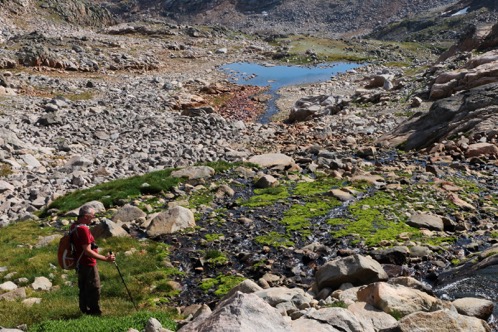
Sometimes causality is mysterious, yet every phenomenon has roots in causes and conditions
Exploring the Beartooths is best done off-trail. Traversing this wild plateau of lakes, boulder fields, snow, waterfalls, and alpine gardens is both liberating and challenging. Route-finding is a central part of the deal. We get to decide what destinations call us out of nearly limitless possibilities. And, we get to discern the best way to get there, which is often unclear and involves complex trade-offs of terrain difficulty, elevation gain, weather risk, and energy reserves.
Sound like leadership? Yes, the Beartooths are a fabulous place to practice the game of leadership. Playing in natural systems provides valuable metaphors and practices to help us navigate the complexities of our leadership contexts. Here are some examples:
Everything perfectly reflects the conditions in which it arose. Asking “how did this come to be?” reveals underlying conditions and processes that favored certain plant species, prevented fish from entering that lake, or arranged large rocks in particular and specific patterns. We saw these phenomena everywhere: iron staining on the rocks on one side of the creek but not the other, moss growing around the rocks, little Zen waterfalls produced by nature.
Sometimes causality is mysterious, yet every phenomenon has roots in causes and conditions. As leaders, we are wise to inquire into the conditions that give rise to particular behaviors. Rather than trying to alter a symptom that is not to our liking, there’s often more leverage in shifting the underlying conditions that birthed the symptom in the first place.
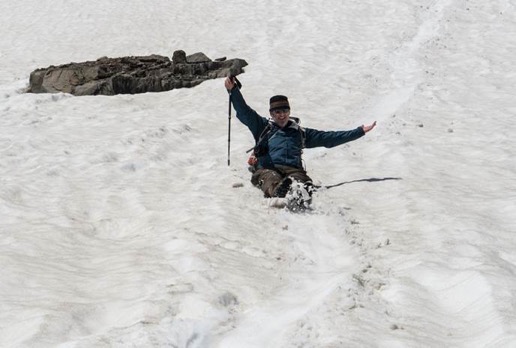
There’s always a way…
There’s always a way… It’s fun, in these mountains, to choose a quest. – “Hey, let’s climb that peak. Discover what this remote lake is like. Descend this preposterously steep snow slope, etc.” – This is the game. The most interesting destinations, actually, are the ones where we don’t know if it’s possible. Usually, it turns out that it is, but it’s the adventure, the excitement of the chase and the discoveries along the way that make it worthwhile. The biggest obstacles, and the joys of getting past them, are usually not revealed until we are fully committed. Evoking a desired future, through declaring commitments, is the essential act of leadership. Often we don’t know how to get there. Kennedy declared that the US would put a man on the moon by the end of the 60’s; Google declared their purpose as making all the world’s information available to everyone. These are audacious commitments. And, if a commitment is strong enough, the way generally becomes clear.
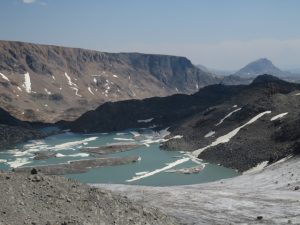
… unless there isn’t
… unless there isn’t. Sometimes, a destination or a route proves impossible or unwise. There actually isn’t a way forward. A descent route turns out, halfway down, to have a cliff band insurmountable without ropes. Or, retreating glaciers leave steep and loose moraines across which travel is very difficult. After climbing a peak for great views of four different glaciers, we ran out of time to return via the floating slabs broken off one of the last glaciers in the range. In our 60’s now, there wasn’t enough margin of energy and time to return by this longer route. While this circumstance wasn’t foreseeable, there’s nothing to do but let this aspiration go. As leaders, we often make personal and collective aspirational commitments without knowing how it will play out. Safe, small commitments reduce this uncertainty; bold commitments always invite the unknown. When things turn out to be impossible or unwise, we can learn to say “Oh well. Now what?” and not have a big story we tell ourselves about failure. That’s not to say that we don’t learn when we make mistakes. Only that we move on quickly and gracefully to whatever is next, grateful to have had the chance to play in the first place.
Stay in action. There are lots of places in the Beartooths where there are extensive boulder fields to cross, climb or descend. One way to move in this challenging terrain is static. We balance, using poles, stabilize ourselves on a boulder, assess the next move, and then take a step. After each step, we stop and decide what’s next. This is pretty slow going, but feels conservative and safe and predictable.
The second method is dynamic, and best done without poles. We move fluidly across the rocks, crossing creeks, staying in motion. Our gaze is always scanning two or three steps ahead, and we adjust and correct fluidly and constantly as we move across the boulders. Moving this way is much faster, more fun, and actually easier. This
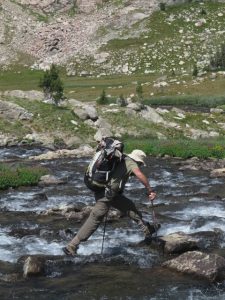
Dynamism requires trust in our capacity to make adjustments on the fly when our foot placements and balance aren’t quite right.
Dynamism requires trust in our capacity to make adjustments on the fly when our foot placements and balance aren’t quite right. As leaders, we often make moves that aren’t guaranteed. In a fast-moving world, we have to trust in our own improvisation, keeping things in motion and adjusting as we go. A move in the right direction produces new information and changes our circumstances; we can fine-tune as we go.
There are countless other parallels. My meaning-making machinery was going full tilt during our wild and wonderful 8 days in wilderness.
Leading is a similar process of reading the conditions, establishing aspirational commitments that aren’t guaranteed, accepting reality as it appears, and staying in action towards what we care about.
***************
Your turn to consider the context in which you are leading:
- What curious results are you noticing, and what might they reveal about underlying conditions?
- What could you trust more about the way forward?
- What if your initiative turns out to be not viable? How could you be OK?
- And, where might you be bolder at staying in dynamic action, without knowing all the next steps?
Please add your comments and reflections!








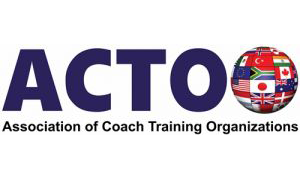
Leave a Reply
Want to join the discussion?
Feel free to contribute!